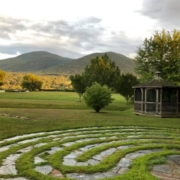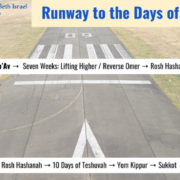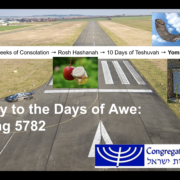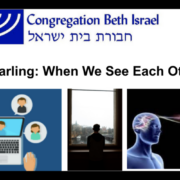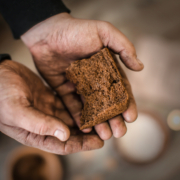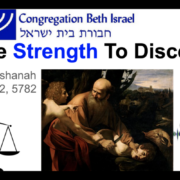As we approach the High Holy Days, we’ve entered a period of reflection and assessment. In addition to my own personal reflections, I am also very aware of the passing of one year and the beginning of the next in the communal life of Congregation Beth Israel. With a year under my belt as president, it is a time when I reflect both on what has gone well and what more we need to or can do.
As I write these words, it isn’t yet quite August. But believe it or not, we’re on the runway to the Days of Awe.
Earlier this summer, I copied down a Chinese proverb, though an internet search suggests that this many not actually come to us from China after all! But the words resonate with me regardless: “Keep a green bough in your heart, the singing bird will come.”
(Image source: madebychook.)
Keep a green bough in your heart; the singing bird will come. Or as we heard from Mariame Kaba on Rosh Hashanah, hope is a discipline.
It feels like an apt seasonal teaching as we approach the autumn equinox and the darker months of the year. It feels even more like an apt spiritual teaching, especially in the midst of pandemic, in times when it feels like our certainties are shifting beneath our feet.
Making a space for hope in our hearts is a practice, which is to say, it takes work. We need to till the soil, plant the tree, keep the tree alive, and then the bird will come with exquisite liquid song. Hope doesn’t come because we’re lucky. Hope comes when we make a space for it.
It takes strength — gevurah — to cultivate that space in our hearts, especially when the news makes us want to close our hearts tight against anticipated loss and even against each other. It takes strength to have the vision of the singing bird that isn’t yet here, the hope that we may not yet feel, the healing that isn’t yet.
In this morning’s Torah reading we heard רְאֵ֨ה נָתַ֤תִּי לְפָנֶ֙יךָ֙ הַיּ֔וֹם / “See, I place before you today…” Yom Kippur calls us to see what has not yet come to pass — because our choices will determine which future we enter. We get to choose curses or blessings, hardened hearts or opened ones, despair or hope.
In a sense, the whole of 5782 is an opportunity to pause and see what isn’t here yet.
Torah teaches that every seventh year should be a shmita year: a year-long Shabbat for the land. We’ll learn more about that later this year (so stay tuned for updates on study and action opportunities this winter and spring). As the climate crisis intensifies, how will our choices and our policies and our culture lead us to care for our planet? How can we not only keep a green bough in our hearts, but also preserve and protect the ecosystems of our planet… especially now, when everything feels so broken — when everything is so broken?
Our mystics teach that at the first moment of creation, there was breaking. God’s infinite light was too powerful to be contained. The initial vessels created to hold that light didn’t have enough structural integrity, enough gevurah, and they shattered. So God tried again, and the second time, creation “held”… but shards of those broken first vessels remain. There is brokenness everywhere we look, and that’s not new.
Our mystics also teach that we have an integral role to play in repairing the world’s brokenness. When we do mitzvot, we uncover the hidden sparks of primordial light buried beneath the shards, and we lift them back up to their Source. We repair the world. We repair God, as it were.
I love this teaching for two reasons. First: it doesn’t sugarcoat the brokenness. Things are broken — between global pandemic, and inequality and racism and xenophobia, and the climate crisis, and assaults on civil rights and on our democracy — and our religious tradition is not going to pretend that away.
And second: it empowers us to bring repair. This is our task as Jews and as human beings in the world. We lift up sparks every time donate to the food pantry, or welcome a refugee, or help someone with a uterus get the healthcare they need… and every time we light Shabbat candles or pray or sit in a sukkah, because those mitzvot nourish our souls, and we need that, too.
In the words of the sage Leonard Cohen, “There is a crack in everything: it’s how the light gets in.” We need to see the cracks, the broken places, because pretending them away is spiritually dishonest. And the cracks are also how we see the light shining in. Being able to see both what’s broken, and what repair could look like and how we can get there, takes gevurah.
Some of us don’t like looking at what’s broken. I get that. It’s painful for me too. I struggle most when the brokenness is something human beings created or perpetuate.
What brings me closest to despair is the knowledge that a year ago, we stayed apart to protect each other. There was no vaccine for COVID-19. Today we are vaccinated: honestly miraculous! But because so many people believe the lies — that COVID is a hoax; that masks don’t offer protection, or that they’re a form of government control; that the vaccines aren’t safe, or that they’re a form of government control — the Delta variant is raging. Misinformation and disinformation and outright lies are so prevalent that thousands are once again dying every day. Facing all of that takes gevurah.
Some of us have trouble seeing beyond what’s broken. I get that too. The brokenness is so vast it can seem insurmountable. Facing what’s broken without becoming consumed by that brokenness also takes gevurah.
For me the spiritual question is: what are we afraid of? What are we afraid will happen if we face the brokenness in our communities, in our nation, in our world? And what are we afraid will happen if we allow ourselves to cultivate hope for better?
I suspect we’re afraid of facing injustice because we’re afraid of despair. I feel that. I know that if I let myself see those things clearly, I am going to need to ask: what am I willing to do in order to create change, and what am I willing to give up to make space and time for that work?
And I suspect we’re afraid to let ourselves hope because we don’t want to be disappointed. If hope is something that just happens, without any agency on our part, that fear makes some sense — hopes can rise and hopes can be dashed and either way it’s not up to us. But in Mariame Kaba’s framing, hope is a discipline. Which brings me back to our mystics and their teaching that when we do mitzvot, we lift up fallen sparks. Doing mitzvot also is a discipline, a practice. Jewish tradition calls us to do mitzvot, recognizing that in the doing we might rewire our souls and even heal God. And even if we don’t feel changed, doing mitzvot still makes the world a better place.
See, I place before you today blessing and curse, says Torah. The Hasidic master known as the Me’or Eynayim points out that good and evil have been mixed together since the beginning of our human story, and they are mixed together within us, too. Our task, he says, is to empower our innate goodness. I think he means something like: our morality, our integrity, our attachment to truth. Translator R. Art Green notes that our moral disposition affects how we see the world, especially the actions of others. A tzaddik (a righteous person) is someone whose own goodness causes them to see the good in others, and therefore to treat others with compassion.
It takes gevurah to see the best in others, not just one time but as a constant practice. If someone stands me up for a meeting, I could think, “ugh, they don’t value my time, I don’t want to engage with them,” or I could choose to think, “Hm, I wonder what’s going on with them; I should check in and make sure they’re okay.” Halakha (Jewish law, our tradition’s sacred path) asks us to do the second of these: to give each other the benefit of the doubt. Seeing each other through generous eyes takes gevurah! And…how we see each other can impact what actually is.
There are a few people in the world I wouldn’t want to sit down with until they did their work, repaired their harms, and showed themselves to have changed. But in most cases, we’re what Hasidic tradition calls beynonim — in-between-ers. We’re not perfect, and we’re not terrible: we’re somewhere in between. It’s in that in-between space that I think we can make the greatest difference by giving each other the benefit of the doubt, seeing each other through generous eyes. This isn’t a Pollyanna move. It asks a spine of titanium alongside an open, curious heart.
It takes gevurah to build relationships when we disagree, identifying common ground while holding the reality of our differences. It takes gevurah to balance generosity of spirit with holding each other (and ourselves) accountable. It takes gevurah to discern when we should “grade on a curve” and when we should demand better from others and ourselves. It takes gevurah to see each other, and the world, into being better than we have been before.
Mariame Kaba asks, “what’s the next best thing you can do from where you are?” Not “how are we going to fix everything,” but what is the next good thing we can do from where we are.
Envision a better world, and take one step closer. And then another. As our sages teach, “It is not incumbent on us to finish the task, but neither are we free to refrain from beginning it.”
It’s tempting to imagine that if we could just feel hopeful, then we’d be energized to repair the world. But I think that’s backwards. Our job is to see what hasn’t yet come to pass — the good that isn’t here yet — and then live it into being. We lift up the sparks, we look for the good in each other, we envision a better world and take one step closer to it, because those actions are how we cultivate the ground of our hearts to sustain the green bough where hope can make its home.
This is the sermon Rabbi Rachel offered at CBI on Yom Kippur morning (cross-posted to Velveteen Rabbi.)
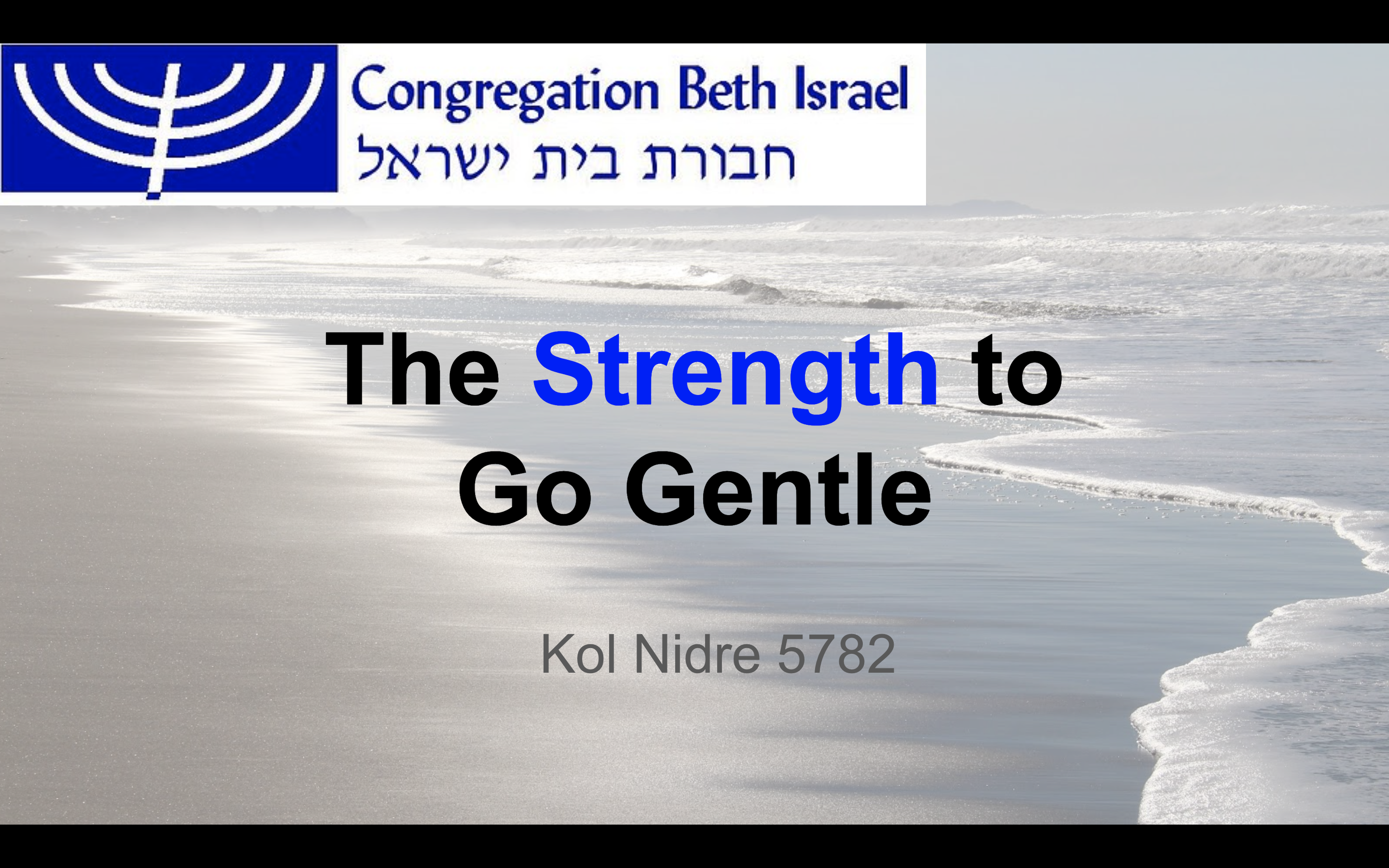
Did you know that Shakespeare wrote King Lear while quarantining for possible exposure to the Bubonic plague? Possibly also Macbeth and Antony and Cleopatra. I assume all of us wrote at least one great masterwork of literature during the last year. No?
Surely at least we started baking with sourdough during the pandemic, creating spectacular loaves and sharing them on Instagram. Or maybe we reorganized our entire storage system, or finished all the home improvement projects we hadn’t had time to complete before, or learned a new language on Duolingo.
The idea that we were “supposed” to do something great and meaningful during quarantine has become a meme, a running joke. As though that were the way to “win” at lockdown and isolation amid global pandemic. We laugh, but the laughter is uneasy. On some level, maybe we wonder: if I didn’t spend this first 18 months of pandemic doing something I can brag about, am I doing it wrong?
Kol nidrei: all the vows and promises and oaths that we fail to live up to…
Maybe we promised ourselves that 5781 would be the year we would finally start working out, or the year we would actually open those cookbooks, or the year we would learn to bake sourdough or write a screenplay… especially since many of us were sheltering-in-place or working from home, so obviously we had all that spare time, right? And instead it turned out that 5781 was a year that we spent trying to keep ourselves and each other afloat. It was a year that we spent watching millions die, and grieving, maybe grappling with survivor’s guilt. And it was a year that we spent watching some people politicize mask-wearing and vaccination, even questioning whether or not the virus is real.
In some ways, the jokes about sourdough and King Lear feel like gaslighting. They ask us to pretend away the inconceivable awfulness of what we’ve witnessed in the last year. ICUs filling with COVID patients again and again. Crematoria in India working overtime. Vaccine shortages in Asia and Africa, paired with vaccine refusers in our own country. And the climate crisis. And the assault on democracy. Our grief and our fear and our compassion have been in overdrive for so long: many are exhausted, or numb, or overwhelmed. And yet somehow we’re supposed to imagine that we’re supposed to ignore our heartbreak and fear and be productive, and if we failed at that, we’ve missed the mark? As though we needed another reason to feel lousy about ourselves tonight!
But feeling lousy about ourselves misses the point of today altogether. Yes, the liturgy of Yom Kippur reminds us that we missed the mark. Even if we’d spent every minute of the last year trying to pursue justice and act with compassion, human beings make mistakes. But the point isn’t self-flagellation, it’s promising in community (and as a community) that we will try to do better.
My image of God is not the angry teacher who can’t wait to give us demerits for all of our flaws. Yes, we’ll spend these 25 hours searching our souls to find the inner work we need to do to be better. But that’s because our tradition gives us this holy season for introspection, calling us to become — not because God is poised to whack us with a ruler. On the contrary. As we heard right after Kol Nidre, “vayomer YHVH, salachti kidvarecha!” And God says: I forgive you, as I said I would! We use the spiritual tools of prayer and contemplation and song to open our hearts so we can feel that forgiveness and be ready to try again.
This year, I also imagine God saying: hey, be gentle with yourselves. One of my friends said to me, at the start of the long cold pandemic winter, that she was grading herself on a curve this year. Some days she felt able to be productive. Other days, it was all she could do to get through the day. And on those days, she gave herself permission to be as she was. What she called grading on a curve, I think of as being gentle with ourselves.
In times of intense grief, clergy and therapists both say to lower the pressure we put on ourselves. I learned this anew when my mother died and grief fogged my vision. When we’re living with sorrow or uncertainty or trauma (or all of the above), just making it through the day can take all we’ve got. Over the last 18 months of pandemic, we’ve all been in that place, sometimes.
Every year at this season we take a good hard look at our failings, and it’s easy to get stuck there — maybe especially this year. Maybe we didn’t take care of ourselves, or we ate and drank too much. Maybe we gave in to despair and doomscrolling, or we turned a blind eye to the world’s suffering…
Jewish tradition calls us to look clearly at where we missed the mark, and it also calls us not to cling to our perceived shortcomings. God is always ready to forgive. That means that God also forgives us for not baking Instagram-worthy sourdough or writing a novel or becoming fluent in Hebrew during this second pandemic year.
Tonight asks us to hold two competing truths in balance. One: Jewish values demand that we constantly work toward justice and healing for this broken world. And two: when we really make teshuvah (when we turn ourselves around, when we do our inner work), God forgives all of our failings. We need to be able to forgive ourselves.
That doesn’t mean there are no standards and anything goes. Gevurah — our theme for this year — asks us to maintain accountability for ourselves and for others. There are behaviors that are simply not okay. Torah is clear that lying, or cheating, or turning a blind eye to the suffering of others is flat wrong. Tomorrow afternoon’s Torah reading will remind us that God asks us to feed the hungry and care for the powerless, to pursue justice without bias, to love our fellow human beings. That Torah reading also reminds us to offer tochecha, corrective words, if we see our fellow human beings acting unethically — because if we let unethical behavior stand, we become complicit.
And it is also a spiritual truth that sometimes it’s all we can do to get out of bed in the morning. When we’re living with uncertainty or trauma or grief, even the simplest tasks can be monumental. Sometimes we can’t offer tochecha or work toward justice because just completing life’s requisite tasks takes all we’ve got. And that’s okay.
Gevurah also can mean healthy boundaries. Sometimes the boundary we need to draw is one that says: I’m doing the best I can, and this is all I can do, and for now it’s going to have to be enough.
This is part of why we live in community. At any given time, some of us are struggling just to make it through the day. In these times of pandemic and climate crisis, that may be even more true than it used to be. We need to help each other through and remind each other that putting on one’s own oxygen mask first is not only okay, it’s necessary. And at any given time, some of us are doing well enough to make things better for someone else. That’s when it’s our job to be angels for each other, as I said on Rosh Hashanah.
So let’s go gentle into this Kol Nidre night. Let’s promise to help each other through the challenges of 5782. Let’s refrain from comparing ourselves to other people, even if their sourdough loaves look magazine-worthy. And let’s show up with open hearts and commit ourselves to trying to be better, because that’s what we’re here for.
God can forgive us for barely holding it together — even for not being “productive” during the pandemic. Can we forgive ourselves?
This is Rabbi Rachel’s sermon for Kol Nidre this year (cross-posted to Velveteen Rabbi.O)
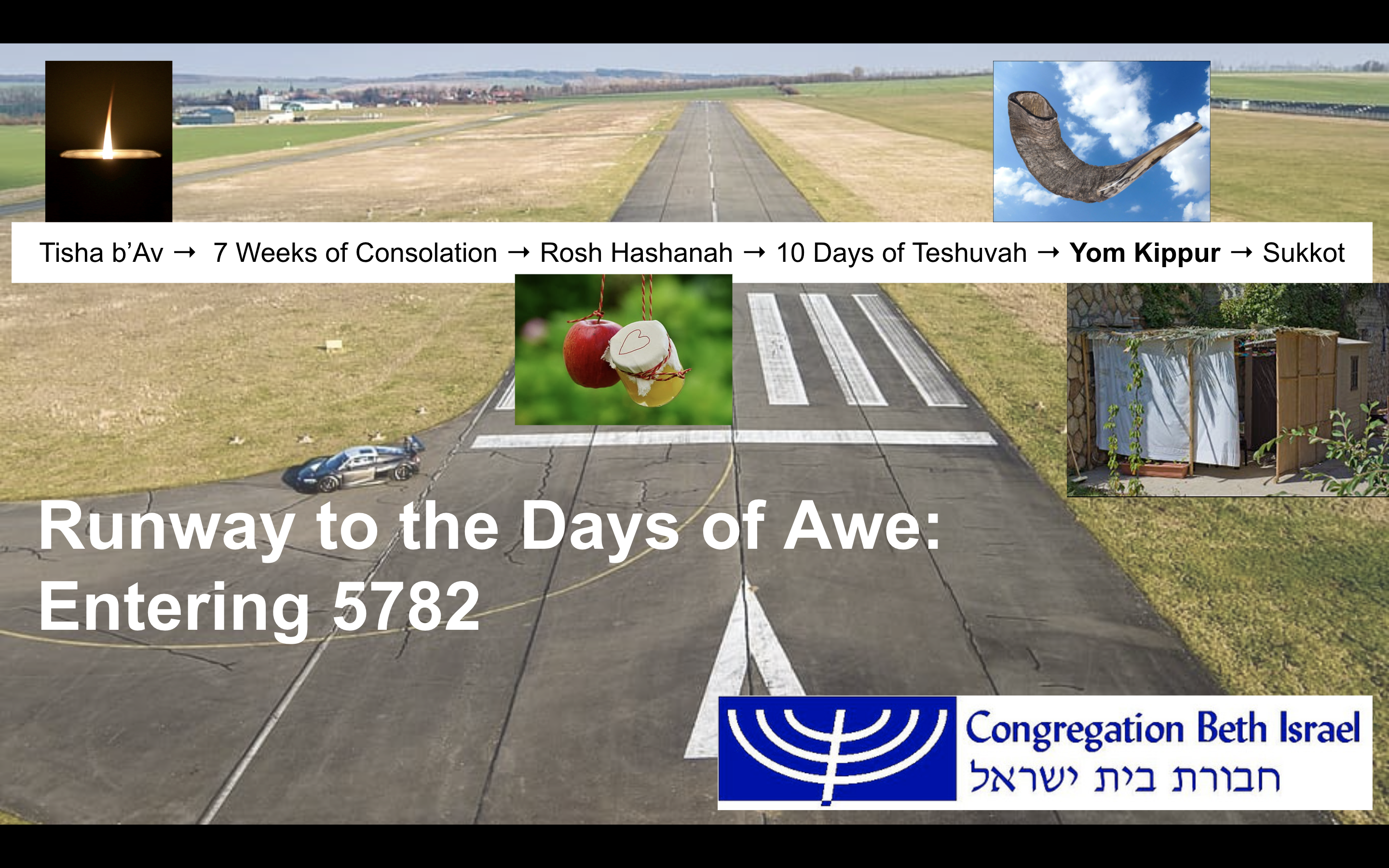
Dear Congregation Beth Israel members and friends,
It was a joy to be with so many of you during Rosh Hashanah. I hope that you are finding meaning in these ten days of teshuvah between Rosh Hashanah and Yom Kippur. Soon we will come together — online and onsite — for Yom Kippur 5782.
For those who are joining us online, here are some suggestions for creating a sacred space in your home. For Yom Kippur in particular, you might want a white tablecloth, a pebble to hold in your hand during Yizkor services, and a photograph or two of those whom you’re remembering at Yizkor — to place beside your Yizkor candle, which you will light just before Yom Kippur and which will burn for about 24 hours. The flame will gutter and go out during Ne’ilah, the closing service that puts a seal on our Yom Kippur.
(Those joining us onsite will have an opportunity to light a Yizkor candle just before Yom Kippur itself begins — you can light one in holy silence while we listen to our new member Robin playing contemplative piano music before Kol Nidre.)
Whether you’ll be with us onsite or online, here is an explanation of some of the holiday’s customs.
Why do we wear white on Yom Kippur?
One way of understanding Yom Kippur is that this is a day of rehearsal for our death. In that understanding, we wear white on Yom Kippur as an approximation of the white garments in which we will be buried. (Some wear a kittel, a simple white cotton robe, worn at sacred times and again at burial.) As members of our chevra kadisha / volunteer burial society know, every Jew is buried in the same simple shroud: plain white garments, the same for everyone rich and poor. Wearing white is a reminder of our mortality and our equality in the eyes of God. On Yom Kippur, wearing white garments that remind us of the garments we will wear when we die can serve as a reminder that we stand every day on the edge of life and death. Tradition teaches us to make teshuvah, to repent / return, the day before our death — which of course is every day, because no one knows when we will die.
Others teach that we wear white on Yom Kippur to be like the angels. We yearn to ascend, to be lighter, more clear and transparent. White is a color of holiness and celebration — that’s why we only have white kippot / yarmulkes available during the holiday season.
Why do some Jews avoid wearing leather on Yom Kippur?
There is a custom on this day of avoiding wearing anything made of leather, because leather requires the death of a living creature. On this day when we make our most fervent teshuvah, we don’t want to be garbed in something which required another being’s death. For this reason, you will see some people wearing canvas shoes, or even rubber Crocs, instead of leather shoes.
Another interpretation is that we substitute soft shoes for leather on this day because we want to remove what protects us. The physical act of wearing soft shoes evokes the emotional / spiritual act of removing the covering from our hearts, allowing ourselves to be vulnerable on this day.
And, of course, you will also see others for whom these interpretations are not meaningful, and who do wear leather, and that’s fine too. Our congregation includes people with many different relationships to halakha (the “way of walking” sometimes translated as “Jewish law”) and to minhag (custom) — and we bring with us many different minhagim (customs) from different communities of origin, too. Some of us wear white. Some of us wear the Jewish version of “our Sunday best” (e.g. the nicest clothes we own). Dress in whatever way will be most meaningful to you.
Why do we wear a tallit at night for Kol Nidre?
Kol Nidre evening is one of the very few times in the Jewish year when a tallit is worn at night. (Though it should be donned before sunset — like the singing of Kol Nidre itself, which also must happen during the day, before Yom Kippur technically begins.) Ordinarily a tallit is only worn when it is light out and we can see the fringes.
There are many reasons why the tallit is worn at this unusual time of day. One is that we sing the Thirteen Attributes (“Adonai, Adonai, El Rachum v’Chanun”) at Kol Nidre services, and there is a very old custom which holds that a tallit should be worn when these are chanted. Another reason is that tallitot are frequently white, and when we wrap ourselves in white tallitot, we can see ourselves as being like the angels, garbed in white light.
For some, a tallit is also worn as a sign of transcendent consciousness; for others the tallit can be a stark reminder of death and the transient nature of physical existence, as the dead are sometimes buried in a tallit in addition to the simple white garments and kittel.
Perhaps we wear tallitot at Kol Nidre because on that night, the “light” of our prayers and our connection with God burns so brightly that it illuminates us from within, and we can see our tzitzit gleaming in that holy light.
A final reason is this: we open the ark for the Kol Nidre prayer, to insure that our prayers are linked to Torah. The person leading the prayers at that time is accompanied by two Torah scrolls. This is done to evoke a court, a “beit din” of three, as a beit din court is needed to annul vows. And when the ark is open, it is traditional to wear a tallit.
One way or another…
May your journey through Yom Kippur this year be meaningful and sweet, and may the holiday get you to where you need to be.
Sending blessings your way —
Rabbi Rachel
Ordinarily on Shabbat Shuvah I would talk about teshuvah, return — turning our lives around, returning to our Source and to our highest selves. This is, after all, the work of the season. But I think that in this second pandemic year, there’s no shortage of time for introspection — a lot of us have been too alone, or turning too inward. So instead I want to talk today about what connects us with each other, and what it might mean to return to each other and to community.
Over the summer I had the opportunity to co-teach a pioneering rabbinic school class on doing Jewish digitally, with my friend and frequent collaborator Rabbi David Markus. We covered a lot of ground, ranging from the nature of prayer and ritual, to wise use of visuality, to creating spiritual and tangible “runways” into the digital ritual experience. And in one of our sessions, we opened with some classical texts about what makes a minyan.
Rambam wrote in the 1170s that “[c]ommunal prayer always is heard [by God]. … Thus, one must join oneself with the community, and never pray alone whenever one is able to pray with the community.” (Mishneh Torah, Prayer 8:1.) This is part of Judaism’s fundamental communitarianism. Can one talk to God alone? Of course! But it’s not good to separate oneself from community. The community needs us to show up, because in coming together to make a minyan, we also come together to make community.
Alongside that, we studied a text from the Shulhan Arukh, written in 1563 by Joseph Karo:
All 10 must be in one place, and the prayer-leader with them…One standing behind the synagogue, and in-between them is a window – even if it is several stories high … – and [whose] face is visible to them from there, joins them to make 10. If a few of them are inside and a few are outside, and the prayer-leader is in the doorway, the prayer-leader connects them [into one minyan]. (O.C. 55:13-15)
The simplest way to make a minyan is ten people in one place, including the prayer-leader. That seems pretty clear. But then he goes on to say: if one person is outside the room, but can be seen from inside, that person can be included. And if some are in one space and some are in another, they can all be included. So long as the prayer leader can see them, that being-seen connects them into one community, even if they can’t all see each other.
As soon as I read that, I thought: welcome to Zoom / hybrid / digital services, y’all.
Joseph Karo could not have imagined Zoom services or the hybrid services we’ve been holding all summer, with some participating onsite and others participating online. But he was already wrestling with this question that’s live for us now: how do we create sacred community when we’re not all in the same physical place?
For Karo, community arises when we can see each other. If I lead a service and it’s broadcast on television, the people watching it might or might not have a meaningful experience — but they can’t be counted in a minyan together, because there’s no two-way connectivity. I can’t see them, and they can’t see each other. I think he’s right, which is why I’ve made a practice of including periodic “face to face” slides where we stop the screenshare and meet each others’ eyes.
I think he’s on to something in a deeper spiritual sense, too. What makes us a community is not whether or not we can convene to pray in the same room at the same time… because if that were the case, then anyone who doesn’t show up to pray ceases to be part of the community! and if that were the case, then our community would have evaporated when the pandemic hit and we, along with so many others, started sheltering in place at home.
We become community when we see each other. I would go further: we become community not just when we glance at each others’ faces, but when we try to see each other fully. When we see what matters to each other. When we see what enlivens each other. When we see not only each others’ faces but each others’ hearts.
It turns out that when we see each other, something in us changes. Mirror neurons are brain cells that fire their electrical pulses both when we do a thing, and when we see someone else do that same thing. This was first observed in monkeys in an Italian lab some thirty years ago: electrodes in their brains showed neurons firing when they handled food, and when they saw someone else handle food — even when they merely heard the sounds of food being handled outside of their line of sight. Some researchers think that mirror neurons explain why we can have strong emotional reaction to characters on TV or in movies: because when we see them, we feel-with-them.
Being together on Zoom is not the same as being together onsite. We can’t sing in harmony on Zoom, or hug each other, or have that feeling of being together in a room. But when we see each other, our mirror neurons still work their magic.
For Joseph Karo, one of the roles of the shaliach tzibbur (the prayer leader) is to see all the souls in the room — and in seeing them, to constitute them into community. This is not a rabbinic job per se. Any adult Jew who learns the liturgy can lead the community in prayer. And any one of us who makes an effort to really see the other souls in the room can create some of the cohesion that makes us a community.
As you’ve heard me say several times this year, our theme for this year’s Days of Awe is gevurah, which means strength and power. It means boundaries. It evokes resilience and courage, too. It takes gevurah to really see each other, to be mindful of where I end and where you begin, to honor our differences without diminishing what connects us. It takes gevurah to connect with each other in these pandemic times when we may feel overwhelmed or despairing, or we may find the technologies of Zoom opaque. It takes gevurah to create community.
An invitation: to see each other deeply.
To awaken our mirror neurons as we see each other.
To create community together by seeing each other where we are, as we are, in all that we are.
Cross-posted to Velveteen Rabbi.
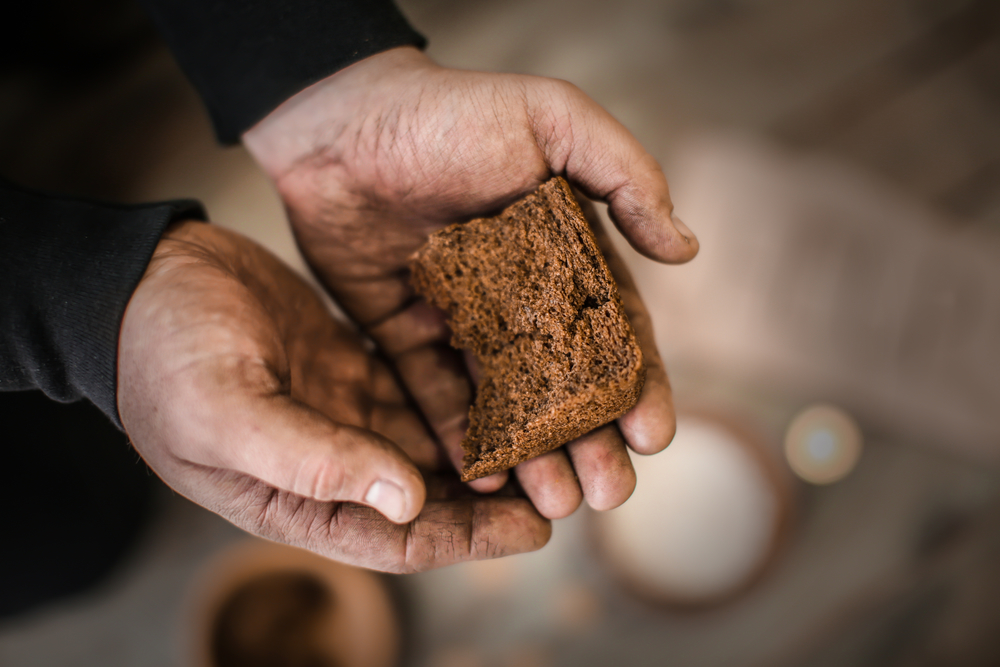
Dear Congregation Beth Israel members and friends,
During the Days of Awe, many synagogues hold food drives for dried and canned foods. We have done this for many years at CBI, in order that the Yom Kippur fast from food and drink be meaningful.
As it turns out, food pantries typically prefer monetary donations to canned food donations. Money doesn’t need to be sorted (as our bags of dried and canned foods do); money does not expire; money enables them to choose what they want and need to feed patrons, rather than relying on what are all-too-often unwanted old cans; and the food pantry can stretch our dollars to purchase more in bulk than what they would be able to provide via our donated cans and boxes alone.
Although not all of us fast from food and drink on Yom Kippur, we can choose to donate to local food pantries during this sacred season. Feeding the hungry is a mitzvah, and so is caring for our local community.
This year, please donate as you are able to help all who are hungry come and eat. You might donate to the Berkshire Food Project, the Friendship Food Pantry, or the Williamstown Food Pantry… or support Mazon: a Jewish response to hunger.
Jewish tradition holds that even one who receives tzedakah is obligated also to give it. What matters isn’t how much we can give, but that we give. Many of us have the luxury of knowing that our stomachs will grumble with hunger on our holy day of fasting but not on the days before and after. Let’s do what we can to ensure that no one in our community goes hungry.
G’mar chatimah tovah — may we be inscribed and sealed for goodness.
Blessings to all,
Rabbi Rachel
On Sunday evening I offered a tiny pearl of introduction to this year’s high holiday theme of gevurah. Yesterday morning we talked about the strength it takes to help each other find hope.
Today our exploration of gevurah comes via the Torah reading for this morning.
Our mystics taught that God’s infinity is revealed in creation through a series of sefirot, divine qualities or emanations. These are the channels through which God’s infinite energy flows into the world, and we associate each one with a quality that we and God share. Like chesed, lovingkindness — last year’s high holiday theme. And gevurah, boundaries and strength and power and discernment — this year’s theme.
When our mystics look at the figures in Torah, they associate different characters in Torah with each of the sefirot. Abraham is associated with chesed, lovingkindness. His tent was open on all sides, he rushed to prepare a feast for visitors, he represents flowing love. And his son Isaac is associated with gevurah.
One of the reasons why Isaac is associated with this spiritual quality is surely the story we just heard, the “binding of Isaac.” How do we see Isaac’s strength in this story? Arguably, what we see is him holding still and letting himself be bound. Maybe he feels powerless, or overwhelmed, or out of control: we don’t know, because Torah doesn’t tell us! But to me, his gevurah has a kind of stoic, silent perseverance to it. He holds still and trusts that he will make it through somehow.
Abraham showed tremendous gevurah earlier in Torah. In midrash, we learn that his father was a builder of idols, and young Avram smashed them. It’s a great story: Terach comes home, all of the idols in his shop are smashed save one, and the biggest one has a stick in its hand. And he yells, what did you do?! and Avram says, “oh, it wasn’t me, dad, the big one did it.” And his father says, “You know they’re just stone. They can’t move!” and Avram retorts, “so why do you worship them, then?” It took gevurah to stand up to his dad.
Or earlier in Genesis, when God disclosed intentions to destroy Sodom and Gomorrah. Remember, Avraham pushed back: what if there are fifty righteous there, what if there are forty, all the way down to ten. But when it comes to Sarah casting-out Ishmael in yesterday’s Torah reading, Avraham doesn’t do much. He tells God he doesn’t like it, but he doesn’t challenge it. And in today’s story, God makes an outrageous request and Avraham just… does it. As Rabbi Danya Ruttenberg notes, he’s a hero when it comes to the outside world, but with his own sons, he falls far short of offering the protection they need.
One of my favorite ways of reading Torah is to place ourselves in the shoes of everyone in the story. Through the lens of Torah we can see ourselves refracted in new ways. And in empathizing with everyone in Torah’s story, we strengthen our capacity to stand in the shoes of another.
How does it feel to empathize with each figure in today’s story, to feel-into where they are?
Maybe Isaac’s kind of gevurah resonates for us, eighteen months into this pandemic. The pandemic has highlighted so many ways we aren’t in control. We don’t have the power to make COVID-19 go away, and we don’t have the power to require other people to do what’s right. But we can use our strength to accept our circumstances and make the best of the hand we’re dealt.
Isaac must have also felt fear. His father had the knife raised for the strike before the angel intervened. We too feel fear in these pandemic times. What might it mean to follow in Isaac’s footsteps and do what life’s situation asks of us, even when we feel afraid?
I don’t especially want to empathize with today’s portrait of Avraham. But like Avraham who followed instructions in today’s story, we too hear voices — day and night, over the internet and cable news and social media — telling us what to do and why. We may be more like Avraham than we want to realize.
Today’s Torah reading begins with the words, “After these things, God tested Avraham.” in English we call this the “Binding of Isaac,” but Torah calls this a test. I’ve always felt that Avraham failed the test: he should have pushed back. He didn’t exercise the discernment to recognize that God’s instruction here was wrong. Discernment is part of gevurah, too.
Gevurah asks us to discern when the voices we’re listening to are giving us good advice and when they’re not. Sometimes the voices we hear are self-serving or toxic. Some voices today declare that the masks we wear to protect against airborne infection are “muzzles” that take away our freedom. Other voices proclaim that as human beings in a society we have a responsibility to take care of each other. What voices will we heed in 5782?
Recently, as I was studying this story again, my son asked me what I was learning. His Hebrew name is after my maternal grandfather, Isaac — in Hebrew, Yitzchak, the name of the son whom Avraham almost sacrificed. I realized he didn’t really know this story yet. So I told it to him, in outline, curious to know how it would land with him.
(And yes, he gave me permission to tell this story to you today.)
His first reaction was: God — He, or She, or They — probably isn’t giving us the full story here. “God is giving us pieces and parts to figure out for ourselves, but God might overestimate or underestimate us.” And then he said, “Loyalty to God is a good thing, but Abraham could have found a loophole. We have choices. We need to feel in our jellies when we’re treating people wrong or making a wrong choice.”
I said, “You mean, we need to learn to use our discernment?” Yes, he said. That’s a good word for it.
We need to use our discernment to know when the voices we’re following are aligned with our highest values — and when they’re not. Discernment is another way of saying, gevurah.
It’s also noteworthy who’s not in this story. Sarah appears nowhere in this part of the narrative. The next thing we read, after this story, is that Sarah died at 127. From that juxtaposition one midrash imagines her hearing the news from afar, perhaps in a garbled form indicating that her husband actually sacrificed their son, and dying on the spot.
After the way we saw Sarah behave yesterday — banishing Hagar and Ishmael into the desert — I don’t especially want to empathize with Sarah, either! But when I place myself in her shoes, I can feel her grief and horror at the news of her child’s death. (Of course, that news turns out to be wrong. Fake news, as it were. But she still grieves — and dies.)
It takes gevurah to place ourselves in someone else’s situation. It takes gevurah to rein in our own reactivity so we can empathize with someone’s heartbreak even if their past behaviors made us angry. Empathy might seem like an expression of chesed, lovingkindness — but I think it requires our gevurah.
Maybe this feels a little bit uncomfortable. Maybe we don’t want to empathize with people who we perceive made bad choices. That’s a very human response. To our ancestors, it was also an angelic one!
We see this in a midrash on part of the Exodus story. When we crossed the sea, Talmud says, the angels rejoiced when the waves crashed in and washed away the Egyptians. This is Pharaoh and his army we’re talking about. They had caused unimaginable suffering. And God says, “the works of My hands are dying, and you want to sing praises?!” Like — what’s the matter with you; develop some empathy, would you?! For this reason we pour out drops of juice or wine, symbol of joy, from our second cup at seder. We diminish our joy because someone else suffered in our journey to liberation.
Not wanting to empathize with someone we don’t like or don’t agree with is a very human reaction… and that midrash comes to teach us that Jewish values ask us to rise above that reaction.
Gevurah is how we balance between feeling our righteous anger, and reining in our anger so that we don’t lose empathy. Gevurah is in how we exercise judgment, especially when it comes to which voices we will heed and amplify. Gevurah is in the strength to be still and trust sometimes, and the strength to take bold action sometimes, and the discernment to know which times are which.
And gevurah is what allows us to be alert for possibilities of hope that we hadn’t previously considered — like the ram that appears at the last second in today’s Torah reading, the source of hope that was waiting just outside our vision’s frame.
This is Rabbi Rachel’s d’varling from the second morning of Rosh Hashanah (cross-posted to Velveteen Rabbi.)

(Note: the first part of this sermon is adapted from an article that JTA asked me to write. Then it goes off into new territory — expanding and completing the ideas I articulated for JTA.)
All summer long, I struggled to find the words for this sermon.
The enormity of what’s broken in the world feels paralyzing. Unprecedented heat and wildfires, a flaming oil spill turning the Gulf of Mexico into an inferno, and extreme flooding across Europe and China and Louisiana and New York: “Who by fire, who by water” lands differently this year. Dayenu, that could be enough — and there’s more.
The past eighteen months were hard even for those of us who have it easy (a job, a place to live, no illness). For many the isolation was crushing, or numbing. For many without stable income or a roof overhead, the pandemic has been unimaginably worse. So too for frontline workers and those who jobs are “essential” and often unseen.
When vaccines became available, my heart soared on wings of hope. I felt certain we would be together safely at Rosh Hashanah this year. But I hadn’t reckoned with the power of social media influencers lying about the putative risks of the vaccine, or lying about the virus. The New York Times reported recently that disinformation is now a booming business. As a result, countless thousands are now refusing vaccination, claiming “personal freedom” at the expense of the collective good.
I keep thinking of the parable of the guy in the boat drilling a hole under his own seat. He doesn’t seem to notice that his personal freedom is going to drown everyone else. As a parable, it’s tart and a little bit funny. In real life, it’s horrifying. Dayenu: that too could be enough to spark despair. And wait, there’s more.
Several governors have made it illegal for municipalities to require masks. To many, masks have become a symbol of government control. To me, a mask is literally the least we can do to protect the immunocompromised (and children.) Refusing to wear a mask during this pandemic is like leaving your lights on during the London Blitz.
Between the anti-maskers, and the anti-vaxxers, and the new Delta variant, cases are rising again. We’re facing another long winter of mounting death counts — and it didn’t have to be this way.
Between what we’re doing to our planet (disproportionately harming those who are most vulnerable), and the impact of anti-maskers and anti-vaxxers on public health (ditto), and the persistence of the Big Lie that the presidential election was “stolen,” it’s hard not to despair. How could I write sermons from this place? I’m pretty sure no one comes to High Holiday services to hear their rabbi say she’s given up.
I poured out my heart about this to my hevruta partner, who reminded me that in Torah even God despaired of humanity sometimes. When God despaired of us, it was our ancestors’ job to push back and remind God of reasons to hope for humanity’s future. This is part of why we live (and learn!) in community: to help each other find hope when our hearts despair.
Our Torah readings for today and tomorrow cue up that inner journey. We just read about the casting-out of Hagar and Ishmael, a tale of how jealousy almost caused a child’s death in the desert. Tomorrow, the stakes may feel even higher with the binding of Isaac. And yet these same Torah stories also remind us of hope in tough times. An angel opens Hagar’s eyes to a flowing spring, and she and her son are saved. An angel opens Abraham’s eyes to the ram caught in the thicket, and Isaac’s life is spared.
The Days of Awe open the door to new beginnings, even when (or especially when) we can’t see our own way back to hope for change. Our job is to be be those Biblical angels for each other: helping each other reach the hope a that we can’t find alone.
Our Torah stories for Rosh Hashanah are stories of courage and strength. Hagar needed courage and strength when she set out into the wilderness with her son and a single skin of water on her back. Isaac needed courage and strength when he lay down on his father’s altar on the mountaintop. In Hebrew, one word for this kind of courage and strength is gevurah: our theme for this year’s Days of Awe.
We’ve seen a lot of gevurah in this difficult year. In the firefighters battling horrific blazes across the Pacific Northwest and California and Turkey and Greece — in the doctors and nurses working in every covid ICU — in the police officers who defended the US Capitol from an angry mob. Those are extraordinary forms of strength and courage.
I want to name and uplift a different kind of gevurah. I mostly didn’t watch the Olympics this year. (That’s not the courageous part.) I just couldn’t get excited about the pageantry or the competition this time around. But Simone Biles caught my attention even so.
Everyone seems to agree that she’s one of the most extraordinary gymnasts of all time. I can’t do a cartwheel to save my life, so I think all gymnasts are pretty amazing, but I can see that she’s more amazing even than most of her peers. And right before the individual all-around gymnastics competition, she withdrew from competition in order to focus on her mental health.
It takes courage to say I’m not okay right now, and I need to do some inner work so I can get where I need to be. A lot of us are not okay right now. Global pandemic, an almost unthinkable amount of death, the climate crisis, the rise in misinformation, the deep divisions in our body politic — the world is not okay right now.
Simone Biles said she “got the twisties,” a condition in which an athlete loses their spatial awareness and can’t tell up from down. Given the kind of literal acrobatics involved in Olympic gymnastics routines, losing her spatial awareness could be deadly. But reading about it, I realized it’s an apt description of how a lot of us are feeling emotionally and spiritually. We’ve lost access to some of the certainties that oriented us. It’s hard to trust in things that used to seem stable. I think we all “have the twisties” a little bit this year.
I’m going to go out on a limb and speculate that none of us can do the gymnastics routines that Simone Biles can do. But all of us can follow the courageous example she set. And she didn’t make that decision in a vacuum. She said she was inspired by Naomi Osaka, the pro tennis player who withdrew from the French Open in order to tend to her mental health. Using our Torah metaphor, Naomi Osaka was Simone Biles’ “angel” — the messenger whose words and actions helped Simone admit that she wasn’t okay and begin to work toward healing.
Because here’s the thing: we’re not in this alone. Even if we feel fundamentally alone sometimes, we have each other. This is why we live (and learn) in community: so we can help each other find the flowing spring that will sustain us in the wilderness, or the ram whose presence will save the day, caught in a thicket just beyond where we ourselves can see. We live in community so we can inspire each other to hope and to build. We live in community so we can strengthen each other.
The activist Mariame Kaba offers some deep wisdom about hope. “Hope doesn’t preclude feeling sadness or frustration or anger,” she says. “Hope is not optimism. Hope is a discipline.” She goes on to say:
Hope is a discipline and… we have to practice it every single day. Because in the world which we live in, it’s easy to feel a sense of hopelessness, that everything is all bad all the time, that there is nothing going to change ever, that people are evil and bad at the bottom. It feels sometimes that it’s being proven in various, different ways, so I get that, so I really get that. I understand why people feel that way. I just choose differently. I choose to think a different way and I choose to act in a different way.
When she says hope is a discipline, what I hear is that it’s a practice — like a yoga practice or a spiritual practice. And the more we practice it, the stronger we become. She names this as a choice: we can choose to let despair overwhelm us, or we can choose to strengthen our hope. This, too, is gevurah.
5781 was not an easy year. I don’t know what 5782 will bring, but I’m pretty sure the challenges of the old year will follow us into the new one. What can we do for each other to give each other courage, to help each other hope? Jewish tradition teaches that even those who receive tzedakah are also obligated to give it. In other words: even if I’m in need of assistance myself, I’m obligated to give what I can to someone else in need. I love this because it breaks down the binary between giver and receiver. And it works as a teaching about intangibles, too. Even if I need emotional support, I can still offer support to others.
Helping others is part of Jewish spiritual practice. Focusing on “ugh, who’s going to help me through this” sometimes is normal, but it’s also self-centered, and it can lead to feeling more alone. Focusing instead on “how can I help someone else” lightens our hearts. Helping others is good for the soul. If you prefer, here’s a social science framing: studies show that when we help others, we feel more energetic, stronger, and more hopeful! And that’s true whether we’re doing organized volunteer work, or “just” offering a listening ear over the phone or Zoom.
Helping each other cultivate hope does not change the realities of pandemic or injustice or fires and floods. But it can help us be resilient in the face of those realities. It can help us make meaning in the face of those realities. This is our work: to use our gevurah to support and uplift and strengthen each other, so that together we can resist despair and keep working toward a better world.
This is Rabbi Rachel’s sermon from the first morning of Rosh Hashanah (cross-posted to Velveteen Rabbi.)

